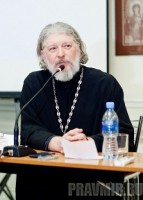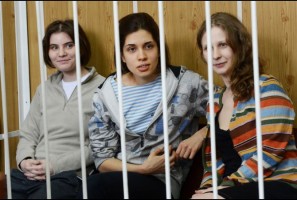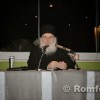Frederica explains to non-liturgical Christians why the actions of the recently convicted Russian protest group were sacrilege and especially insensitive to the Orthodox individuals who remained faithful throughout the Soviet era.
Transcript:
Recently there was a trial in Russia of women who had sung a song, a sort of mocking prayer, in Christ the Savior Cathedral in Moscow. Some of my friends, even Christian friends, didn’t understand what Orthodox Christians were upset about. Why did it seem to us like it was a sacrilege and not just a protest? The protest was about what the women saw as a too-close entwining of Church and State, so they held it in the church—so why did it matter? I wanted to say something to explain why it doesmatter. It perhaps matters to Orthodox Christians in a way that it might not so much to non-liturgical Christians who don’t have the same expectations of or feelings about their church buildings as liturgical Christians do.
In general, there is a difference anyway. If you were protesting at a government building, you’re having an impact on the people who are in that government. If you’re protesting a business and go to the business headquarters, you’re going to impact the people who are participants in and employees of that business. But it’s different when you protest at a church, because you’re not going to hit only those in power. You’re going to hit all the ordinary people, too, people who don’t have any power over what the Church says or does or what the government says or does. They don’t have any influence. They come to church to pray.
If it’s a midday, midweek, no service going on, the people coming to church are probably worried about something or sad about something. They’ve come because they need to pray. When somebody mocks their faith, it wounds them. That’s wounds them. It’s legitimate to say it really wounds them. And it wounds other Orthodox Christians all over the world who have the same faith, and, again, have absolutely no connection to the people in power who are being challenged by the protest.
What did they do? A lot of people said, “I could not find any description of what they actually did.” It was funny: my husband thinks the media set out to conceal what exactly the protest was. He says heard a report on NPR that didn’t mention until the very last sentence that it even took place in a church. What did they do? I did see a site that not only translated the lyrics of their song—you can see a video, but if you don’t speak Russian, you might not understand it—and also talked about some of the other transgressive acts that they’ve committed and are very frankly sexual, sometimes really involving sexual acts, not just simulated. They have a history of really trying to find where the boundary is and where they can shock and upset people.
They sang a song that in part used obscenities. It referred to “the Lord,” and there was a part of the song that was supposedly a prayer addressed to the Theotokos, asking her to deliver the country from Putin. This was two weeks before the election. It was disturbing to see these women, bowing, making the sign of the cross on themselves. I couldn’t tell whether this was a chant melody or not; it’s very raucous. There was a clip—only a forty-second song. You can see a clip that was played on the Today Show that’s available online.
What caused the pain was that they sang a song that contained obscenities and it was a parody of a prayer. Those who are not Orthodox might not understand why it was so hurtful. A good friend of mine kept saying, “What was sacrilegious about it? I don’t understand. Why was this sacrilege?” For one thing, the altar in an Orthodox church, a Catholic church, or a high-church Episcopal church, perhaps in some Lutheran churches, is felt to be especially holy. It’s not like a church that has worship in an auditorium and it’s the stage of that auditorium. Because Christianity grew out of Judaism, the altar is literally the continuation of the Holy of Holies in the ancient Temple. From what I could see in the video, they didn’t go behind the iconostasis; they stood on the solea. They stood and kicked and danced and kicked impressively high kicks on the solea in front of the iconostasis. I’ve heard some people say they did go behind the iconostasis, so I don’t know. As I was saying, it hasn’t been reported very thoroughly.
The form of the protest—a mocking and obscene prayer—also hits on particular, very painful memories for those who survived Communism. I’ve spoken before on my podcasts about Fr. George Calciu, who I was blessed to have as my spiritual father. He died in 2006. Living, growing up, and being a priest in Romania, he was imprisoned for 21 years in a Communist prison. In the earliest stint of his imprisonment, he was subject to the brain-washing process. They used both physical and emotional torture, and they mocked everything that he loved: his wife and his child and his faith, of course. A very important part of this brain-washing process—it wouldn’t be for Americans, but for Orthodox people, where the Liturgy is such a central part of your life—was mocking Church services, where they’d rewritten the services so they’d included obscenities and celebrations of the “Divine Liturgy” except using filthy matter. Really horribly abusive things were done.
So these obscene and mocking prayers is something that has been done to Orthodox Christians not that long ago, not in the distant past. All Christian prisoners endured this abuse. I’ve heard millions of Orthodox Christians—a very large percentage of the clergy were monastics—died for their faith. 20 million was the number I’d heard who died for their faith. Fr. George survived, and thanks to the efforts of Romanian expatriates, like playwright Eugen Ionescu or Mircea Eliade, because of their protest to Ceauşescu, he was freed. He became known as a political prisoner, he was freed, and he came to America. 1984: it’s not that long ago. These memories are so fresh.
The problem, then, is the mocking of prayers. It’s the form, not the content necessarily, in the sense that a lot of people agree with this point of view. A lot of people are concerned about Putin. A lot of people, even Orthodox people, are concerned about the entwining of the Orthodox Church with the Russian government. Honestly, I don’t have an opinion; I have not studied it closely. I try to stay on a media fast and only learn about things that affect me personally or that I can affect as a citizen. This has nothing that I can change about Russian government, so I’m not involved with that and not well-informed. But as I’ve said, I’ve had many people tell me they share these concerns. That’s the ironic thing. If they had made a sincere prayer—there’s a long history of Christians praying sincerely for the Lord to deliver them from rulers that they believed to be unjust—instead of a mocking prayer, they might have gotten people on their side. Sincerity is always better than mockery; mockery only has the aim of wounding and hurting people.
Also, the church where they did it, the particular place is not just any church. The original Christ the Savior Cathedral was built in the 19th century. It was modeled on the Hagia Sophia in Constantinople, and all the Russian artists of the day filled it up with beautiful icons and artwork. In 1931, the Soviets destroyed it; they blew it up. You can see this footage online. It’s really quite heartbreaking to see this beautiful cathedral ransacked and the holy vessels and vestments and artworks and icons carried out of it. Anything that was valuable was confiscated by the government and sold, icons thrown in the pile and burned. These artworks were destroyed specifically because they had religious content, because they were images of our Lord or of the Theotokos or of saints.
It’s like a few years ago, when those two statues of Buddhas were blown up in Afghanistan. They were destroyed because of their religious content, because it was offensive to have a statue of the Buddha. It’s the same thing here. Those icons were destroyed because they were Christian images.
In the 1990s, as Communism was finally waning and being expelled from power, a popular movement arose in Moscow to rebuild the cathedral. It’s quite an interesting story because the Communists destroyed it, they blew it up, and they had this plan to build a huge 45-story building to be called the Palace of the Soviets. On top of it, there was going to be a statue of Lenin, 25-feet high, and it kept growing and growing; finally, it was going to be 115-feet tall, this statue of Lenin on top of the Palace of the Soviets.
One thing after another: they needed money, they couldn’t afford to build it. It just remained the foundations of the cathedral, just a pit in the ground. It filled with rainwater and trash. It was this horrible thing, from one of the most beautiful sites in Moscow to just a trash pit. Khrushchev, in the ‘50s, had the beautiful idea of turning that around; he made it a swimming pool. It was the largest outdoor swimming pool in the world. What a story that site has had!
In the ‘90s, this movement developed to rebuild the cathedral, to build an exact replica of the cathedral that was destroyed. A million citizens of Moscow donated to this fund, and they did rebuild it. It’s a wonderful story. You can also see online a concert of the 1812 Overture, held in the cathedral shortly before it was finished, so you see the very plain walls. But when the cathedral was first opened in the 19th century, the performance was the 1812 Overture, so that was a very nice touch.
The new cathedral was consecrated in the year 2000, so, again, it’s not that long ago. Memory is still fresh here. This is a unique building, because it was destroyed by the powerful, and it was rebuilt by the people. You could liken it to a synagogue in Germany that was burned by the Nazis, that, years later, the faithful Jewish people of that city raised the money themselves and rebuilt. That’s the equivalent of what these women went into in order to chant blasphemous and obscene prayers as had been chanted at the martyrs—the relatives: the grandfathers, the great-grandfathers, the grandmothers who went into monasteries, the ancestors who had died for their faith.
You’re tempted to say, “This was an extremely insensitive act,” but I don’t think it was probably exquisitely sensitive. I think it was plotted and planned. These women would not be ignorant of this history. They did it deliberately to pour salt in a wound. I don’t think it was as insensitive as it might have been if it was outsiders who had come to do this.
What is the right punishment? I guess the maximum was seven years; they got two years. Some people say that it should have been just time served. In fact, the Church was asking that the sentencing be lenient, because they could see that if it’s harsh, it’s just going to provoke people to do more. You can imagine what would be the sentence if somebody invaded a mosque or a synagogue and chanted parodies of the prayers of the people who worshiped there.
What should be the punishment for someone like that? For me, the thing that first comes to mind is community service. It’s not like there was actual damage to the property. It was open to the public. I don’t know that there needs to be punishment for it, but I think it would be good for these women to really realize what they’ve done and what it does to people when you set out to hurt them that way. They’re talented women, I’m sure. They can sing; they can sure kick high!
Why couldn’t they be assigned to join in a project to capture the living history of all those ordinary people who are never going to write a book or write a song or be famous or give a speech, but the ones who lived through it or who inherited the stories from their parents and their grandparents—before that generation is gone. They did this for the survivors of the Holocaust. Those stories should be collected, and they should be told. The stories of those who died—those stories have to be told by the people who are alive now, or they will never be known; they will be forgotten.
I think that that would be a project that everybody could agree on having a real positive purpose. It could bring healing. It would certainly bring understanding to those who don’t know why it would hurt Orthodox to hear obscene prayers chanted. I think it would strengthen community memory against further abuse. It’s not punishment; it’s prevention. We want people to understand why it’s wrong to do this, and to not want to do that any more.
I think that when you’re young and vigorous and strong like these women are, it can be very hard to imagine that anybody was ever weak or suffering or terrified or persecuted. It’s not something that theyexperienced themselves. You could think, “It can’t happen here.” You know that famous phrase. But it did happen, and it happened right there, right there in that city, and it was not that long ago. This is about memory. So that those who forget the past are determined to repeat it. We do know this, that if you forget the times that the faithful were mocked with abusive and obscene prayers, it isn’t going to be long before we’re hearing those sorts of words again.
Source: Ancient Faith Radio
Author Bio:
Frederica Mathewes-Green is a wide-ranging author, whose work has appeared in such diverse publications as the Washington Post, Christianity Today, Smithsonian, the Los Angeles Times, First Things, Books & Culture, Sojourners, Touchstone, and the Wall Street Journal. She is a regular columnist for the multifaith web magazine Beliefnet.com, and she writes movie reviews for National Review Online.
She lives with her husband, the Rev. Gregory Mathewes-Green, in Baltimore, MD, where he is pastor and she is “Khouria” (“Mother”) of the church they founded, Holy Cross Orthodox Church. Their three children are grown and married, and they have 11 grandchildren.



















